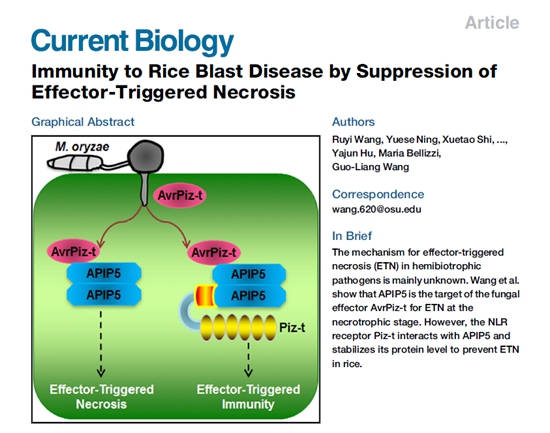分享到
Immunity to Rice Blast Disease by Suppression of Effector-Triggered Necrosis
Hemibiotrophic pathogens are some of the most destructive plant pathogens, causing huge economic losses and threatening global food security. However, how hemibiotrophic pathogens trigger host necrosis and how plants inhibit the transition from the biotrophic stage to the necrotrophic stage in disease symptom expression are mainly unknown. Recently, researchers at State Key Laboratory for Biology of Plant Diseases and Insect Pests, Institute of Plant Protection (IPP), Chinese Academy of Agricultural Sciences (CAAS) have published a research paper about mechanism for effector-triggered necrosis (ETN) in hemibiotrophic pathogens by characterizing the target of Magnaporthe oryzae effector.

The rice blast fungus M. oryzae spreads in rice biotrophically early during infection, but this biotrophic stage is followed by a pronounced switch to cell death and lesion formation. The research results showed that the M. oryzae effector AvrPiz-t interacts with the bZIP-type transcription factor APIP5 in the cytoplasm and suppresses its transcriptional activity and protein accumulation at the necrotrophic stage. Silencing of APIP5 in transgenic rice leads to cell death, and the phenotype is enhanced by the expression of AvrPiz-t. Conversely, Piz-t interacts with and stabilizes APIP5 to prevent necrosis at the necrotrophic stage. At the same time, APIP5 is essential for Piz-t stability. Taken together, these results demonstrate a novel mechanism for the suppression of ETN at the necrotrophic stage by an NLR receptor in plants.
This is an interesting study that is potentially of very high impact to host-pathogens interaction research. Current Biology journal invited a Dispatch paper to emphatically introduce this paper.
More details are available on the bellow links:
http://www.cell.com/current-biology/fulltext/S0960-9822(16)30751-5
By Yuese Ning
ysning@ippcaas.cn

The rice blast fungus M. oryzae spreads in rice biotrophically early during infection, but this biotrophic stage is followed by a pronounced switch to cell death and lesion formation. The research results showed that the M. oryzae effector AvrPiz-t interacts with the bZIP-type transcription factor APIP5 in the cytoplasm and suppresses its transcriptional activity and protein accumulation at the necrotrophic stage. Silencing of APIP5 in transgenic rice leads to cell death, and the phenotype is enhanced by the expression of AvrPiz-t. Conversely, Piz-t interacts with and stabilizes APIP5 to prevent necrosis at the necrotrophic stage. At the same time, APIP5 is essential for Piz-t stability. Taken together, these results demonstrate a novel mechanism for the suppression of ETN at the necrotrophic stage by an NLR receptor in plants.
This is an interesting study that is potentially of very high impact to host-pathogens interaction research. Current Biology journal invited a Dispatch paper to emphatically introduce this paper.
More details are available on the bellow links:
http://www.cell.com/current-biology/fulltext/S0960-9822(16)30751-5
By Yuese Ning
ysning@ippcaas.cn
Latest News
-
 Apr 18, 2024Opening Ceremony of the Training Workshop on Wheat Head Scab Resistance Breeding and Pest Control in Africa Held in CAAS
Apr 18, 2024Opening Ceremony of the Training Workshop on Wheat Head Scab Resistance Breeding and Pest Control in Africa Held in CAAS -
 Apr 03, 2024IPPCAAS Co-organized the Training Workshop on Management and Application of Biopesticides in Nepal
Apr 03, 2024IPPCAAS Co-organized the Training Workshop on Management and Application of Biopesticides in Nepal -
 Mar 28, 2024Delegation from the School of Agriculture and Food Science of University College Dublin, Ireland Visit to IAS, CAAS
Mar 28, 2024Delegation from the School of Agriculture and Food Science of University College Dublin, Ireland Visit to IAS, CAAS -
 Mar 25, 2024Director of World Food Prize Foundation visited GSCAAS
Mar 25, 2024Director of World Food Prize Foundation visited GSCAAS -
 Mar 20, 2024Institute of Crop Sciences (ICS) and Syngenta Group Global Seeds Advance Collaborative Research in the Seed Industry
Mar 20, 2024Institute of Crop Sciences (ICS) and Syngenta Group Global Seeds Advance Collaborative Research in the Seed Industry
